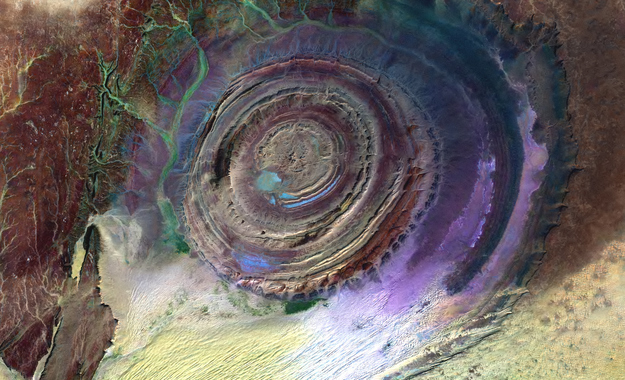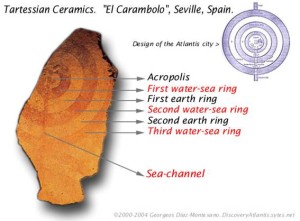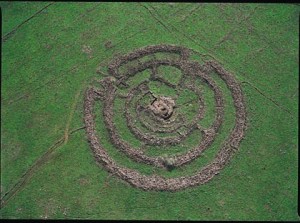Guelb er Richat
Richat Structure, The
The Richat Structure or Guelb er Richat in Mauritania” is regarded by geologists as a highly symmetrical and deeply eroded geologic dome. It was first described in the 1930s to 1940s, as Richât Crater or Richât buttonhole. Richard-Molard (1948) considered it to be the result of a laccolithic thrust. A geological expedition to Mauritania led by Théodore Monod in 1952 recorded four ‘crateriform or circular irregularities” in the area.”(q)
The feature was thought by  many to be an impact crater until it was identified as the remains of a possible ‘salt dome’(a). Some of the more enthusiastic supporters of the ‘Electric Universe’ school of thought have sought to identify the feature as the consequence of an electrical discharge.(e)
many to be an impact crater until it was identified as the remains of a possible ‘salt dome’(a). Some of the more enthusiastic supporters of the ‘Electric Universe’ school of thought have sought to identify the feature as the consequence of an electrical discharge.(e)
This is outlined in an April 2022 paper by Andrew Hall, explaining what he calls the ‘Keystone Pattern’.(r)
Even creationists have claimed that the original surface of the ‘Structure’ had been eroded by Noah’s Flood(t).
The concentric circles of which the structure is composed is clearly revealed by satellite imagery. However, these characteristics are not visible when walking across the structure(u). The scientific consensus today is that the structure is a natural geological feature. In more technical terms a geological ‘dome’ is “A structure that plunges in all directions to form a circular or elongate structure is a dome. Domes are generally formed from one main deformation event, or via diapirism from underlying magmatic intrusions or movements of upwardly mobile, mechanically ductile material such as rock salt (salt dome) and shale (shale diapir). The Richat Structure of the Sahara is considered a dome that has been laid bare by erosion.”(k) Further geological data was available on a German website(v).
It did not take long before it was compared to Plato’s description of Atlantis. However, Ulf Richter has pointed out that it is too wide (35 km), too elevated (400 metres) and too far from the sea (500 km) to be seriously considered the location of Atlantis. Nevertheless, researchers such as Robert deMelo are still prepared to consider it a possible location candidate(b).
50 km west-southwest of Richat is a similar though smaller feature, the Semsiyat Dome, having a diameter of just 5 km(o).
In 2008, George Sarantitis put forward the idea that the Richat Structure was the location of Atlantis, supporting his contention with an intensive reappraisal of the translation of Plato’s text(g). His theory has been published in Greek[1470], with an English translation now (2017) imminent.
In 2006 George S. Alexander and Natalis Rosen were struck by the similarity of the Richat feature with Plato’s description and decided to investigate on the ground. Instability in the region prevented this until late 2008 when they visited the site, gathering material for a movie. The film was then finalised and published on their then-newly-established website in 2010(c).
In 2008, Charles Giuliani self-published Alternative View of The Distant Past [1969]. In this wide-ranging book, the author tackles the story of Atlantis and endeavours to identify the Richat Structure as the location of Plato’s city of Atlantis. His speculations lack scientific evidence and contradict reason. The main weaknesses are his dating of Atlantis (9600 BC) and the logistical problems of launching an attack on Athens 4,000km away from Richat at a time when archaeology indicates that seafaring was carried out with little more than dugout canoes or rafts.
In 2013 further support for linking Atlantis with Richat came from Jose D.C. Hernandez with a rather convoluted theory in a paper entitled A Celestial Impact and Atlantis(f).
Even more bizarre is the claim by Anthony Woods that although Ireland was the island of Atlantis, the city of Atlantis (Cerne) was in Mauritania and is known today as the Richat Structure!
Towards the end of the 2018 media ‘silly season’, the YouTube channel Bright Insight made a pathetic attempt to breathe new life into the Atlantis in Sahara theory. However, it fails on one simple fact; it is not submerged, but for good measure, when Alexander and Rosen investigated the Richat Structure they could not produce a single piece of physical evidence from the 35 km wide site. Where was the bustling port described by Plato? I could go on, but remember, it’s not called the silly season without reason.
Early November 2018 saw the British tabloid press give further coverage to Jimmy Corsetti’s ideas(i)(j) (The Sun gave his name as Jimmy Bright!). His theories are totally dependent on the destruction of Atlantis having occurred around twelve thousand years ago. He does not explain how an attack was launched from Mauritania on Athens which did not even exist at that time. Corsetti, like many others, needs this very early date to explain why the Richat Structure is not underwater today but was gradually uplifted as a result of tectonic forces in the region. However, Plato clearly states that the submerged Atlantis was still a hazard to shipping in his day, a period when the Structure would have been at its present elevation. As no geologic event has occurred during the two and a half millennia since Plato, which could have raised the Structure from the seabed to an elevation of 400 metres 500 km from the Atlantic, we are obliged to give greater credence to the scientific conclusion that the Richat Structure is a natural feature. Corsetti does have at least one fan(n).
It was in 2018 that Corsetti published a video promoting the Richat Structure as Atlantis, which received extensive coverage. Steven Novella, a well-known Atlantis sceptic, published an article debunking Corsetti’s ‘evidence’ in some considerable detail(s). However, while I would endorse Novella’s arguments(l) regarding the Richat Structure, I strongly disagree with Novella’s closed-minded attitude towards the existence of Atlantis as well as Corsetti’s attention-seeking location choice for Plato’s island. I would add that Corsetti has his date wrong and that to launch an attack on Athens nearly 4000 km away by land (3000 km by sea) from the ‘Structure’ is logistical nonsense.
In a recent conversation with Joe Rogan, Corsetti claimed that since the Structure contains salt, it MUST have been submerged and no other explanation is possible. However, as I have pointed out above the Richat feature is an eroded ‘salt dome’ and quite naturally has salt in it without the need for submersion.
>The natural geological origins of the Richat Structure are discussed in some detail in a 2005 paper by three Canadian scientists in the journal Geology, produced by the Geological Society of America. It would be interesting to hear the response of Corsetti to facts compared with his daft speculations(w).<
However, in 2018, Martin K. Ettington published a booklet entitled The Real Atlantis [1641] in which he also insisted that the Richat Structure is the remains of Atlantis but with no real evidence to support his contention.
In Joining the Dots [1590] and in Atlantipedia.ie I have consistently argued that in ancient times, proximity is an essential logistical requirement in order to achieve a successful invasion. This was particularly true in ancient times when all empires expanded through the invasion of neighbouring territories. The Richat Structure is many thousands of kilometres from Athens, so to suggest that an attack was launched from Mauretania on Greece is simply ludicrous.
There is a relatively recent website(m) dedicated to promoting the ‘Structure’ as the location of Atlantis. It is well presented by its author Gergely (Gregory) Dzsida with plenty of content. Unfortunately, I cannot accept its basic claim, To my mind, it fails to answer Richter’s arguments regarding, size, elevation and location as well as my point regarding proximity.
Not unexpectedly, Jason Colavito has a few thoughts to add to this latest Atlantis in Sahara kerfuffle(h).
Although the Richat Structure as the location of Atlantis conflicts with details in Plato’s account as well as reason, it still gathers supporters based simply on its circular shape. A recent example of this came from a Danish commentator, Palle A. Anderson(p).
An even more ridiculous suggestion was offered in 2021 by Carlos Bisceglia in Atlantis 2021- Lost Continent Rediscovered in which he proposed that Atlantis was known to the Egyptians as the ‘Land of Ma’ and that its capital was the Richat Structure together with the Semsiat Dome, mentioned above, which is 50km away. In order to explain how his Atlantis is not submerged, Bisceglia has proposed that the Land of Ma became confused with the submerged Land of Mu (Sundaland) in the Pacific and that “it is possible that Solon or Plato confused ‘the Land of Ma’ with the ‘Land of Mu’, and thus two completely independent accounts were merged into one.” He adds “how the Egyptian priests knew this is a mystery. Evidently, some survivors from Sundaland arrived in some way in Egypt”
In April 2022, David Edward published Atlantis Solved: The Final Definitive Proof [1926], which also endorsed the Richat Structure as the location of Atlantis. The author of this slender 99-page book admits to being greatly influenced by the earlier claims of Jimmy Corsetti.
(a) https://web.archive.org/web/20160326200714/https://www.atlantis-schoppe.de/richter.pdf
(b) http://www.gpofr.com/documents/2012Atlantis.pdf
(c) Visiting Atlantis | Gateway to a lost world (archive.org)
(e) https://www.thunderbolts.info/tpod/2005/arch05/050407richat.htm
(f) https://blog.world-mysteries.com/science/a-celestial-impact-and-atlantis/
(g) The System of Wheels – Plato Project (archive.org)
(h) https://www.jasoncolavito.com/blog/youtube-video-claims-atlantis-is-located-in-the-sahara-desert
(i) https://www.thesun.co.uk/news/7681682/atlantis-sahara-desert-conspiracy/
(l) https://theness.com/neurologicablog/index.php/no-atlantis-has-not-been-discovered-in-north-africa/
(m) Learn from Ancient Civilizations | Find Atlantis Together (archive.org)
(o) http://www.b14643.de/Mauritania-Craters/index.htm (see the end of page)
(p) The Real Atlantis – where is it? (planker.dk)
(q) Richat Structure – Wikipedia
(r) The Keystone Pattern – The Thunderbolts Project™
(s) https://theness.com/neurologicablog/index.php/no-atlantis-has-not-been-discovered-in-north-africa/
(t) https://creation.com/eye-of-the-sahara
Concentric Rings
The Concentric Rings or other architectural features extracted by artists from Plato’s description of the capital of Atlantis have  continually fascinated students of the story and many have attempted to link them with similar ancient features found elsewhere in the world as evidence of a widespread culture. Stonehenge, Old Owstrey, Carthage and Syracuse have all been suggested, but such comparisons have never been convincing. Diaz-Montexano has recently published(a) an image of a fragment of pottery found near Seville in Spain that shows concentric circles and insists that it is a symbol of Atlantis. Ulf Erlingsson has made a similar claim regarding some concentric circles carved on a stone basin found at Newgrange in Ireland.
continually fascinated students of the story and many have attempted to link them with similar ancient features found elsewhere in the world as evidence of a widespread culture. Stonehenge, Old Owstrey, Carthage and Syracuse have all been suggested, but such comparisons have never been convincing. Diaz-Montexano has recently published(a) an image of a fragment of pottery found near Seville in Spain that shows concentric circles and insists that it is a symbol of Atlantis. Ulf Erlingsson has made a similar claim regarding some concentric circles carved on a stone basin found at Newgrange in Ireland.
Less well-known are the concentric stone circles that are to be found on the island of Lampedusa in the Strait of Sicily(b).
In 1969 two commercial pilots, Robert Brush and Trigg Adams photographed a series of large concentric circles in about three feet of water off the coast of Andros in the Bahamas. Estimates of the diameter of the circles range from 100 to 1,000 feet. Apparently, these rings are now covered by sand. It is hard to understand how such a feature in such very shallow water cannot be physically located and inspected. Richard Wingate in his book [0059] estimated the diameter at 1,000 yards. However, the rings described by Wingate were apparently on land, among Andros’ many swamps.
>A recent (2023) report has drawn attention to the ancient rock art found on Kenya’s Mfangano Island where a number of concentric circles estimated as 4,000 years old can be seen(q).<
Two papers presented to the 2005 Atlantis Conference on Melos describe how an asteroid impact could produce similar concentric rings, which, if located close to a coast, could be converted easily to a series of canals for seagoing vessels. The authors, Filippos Tsikalas, V.V. Shuvavlov and Stavros Papamarinopoulos gave examples of such multi-ringed concentric morphology resulting from asteroid impacts. Not only does their suggestion provide a rational explanation for the shape of the canals but would also explain the apparent over-engineering of those waterways.
At the same conference, the late Ulf Richter presented his idea [629.451], which included the suggestion that the concentric rings around the centre of the Atlantis capital had a natural origin. Richter has proposed that the Atlantis rings were the result of the erosion of an elevated salt dome that had exposed alternating rings of hard and soft rock that could be adapted to provide the waterways described by Plato.
Georgeos Diaz-Montexano has suggested that the ancient city under modern Jaen in Andalusia, Spain had a concentric layout similar to Plato’s description of Atlantis. In August 2016 archaeologists from the University of Tübingen revealed the discovery(i) of a Copper Age, Bell Beaker People site 50km east of Valencina near Seville, where the complex included a series of concentric earthwork circles.
A very impressive example of man-made concentric stone circles, known in Arabic as Rujm el-Hiri and in Hebrew as Gilgal Refaim(a), is to be found on the Golan Heights, now part of Israeli-occupied Syria. It consists of four concentric walls with an outer diameter of 160metres. It has been dated to 3000-2700 BC and is reputed to have been built by giants! Mercifully, nobody has claimed any connection with Atlantis. That is until 2018 when Ryan Pitterson made just such a claim in his book, Judgement of the Nephilim[1620].
Jim Allen in his latest book, Atlantis and the Persian Empire[877], devotes a well-illustrated chapter to a discussion of a number of ‘circular cities’ that existed in ancient Persia and which some commentators claim were the inspiration for Plato’s description of the city of Atlantis. These include the old city of Firuzabad which was divided into 20 sectors by radial spokes as well as Ecbatana and Susa, both noted by Herodotus to have had concentric walls. Understandably, Allen, who promotes the idea of Atlantis in the Andes, has pointed out that many sites on the Altiplano have hilltops surrounded by concentric walls. However, as he seems to realise that to definitively link any of these locations with Plato’s Atlantis a large dollop of speculation was required.
Rodney Castleden compared the layout of Syracuse in Sicily with Plato’s Atlantis noting that the main city “had seen a revolution in its defensive works, with the building of unparalleled lengths of circuit walls punctuated by numerous bastions and towers, displaying the city-state’s power and wealth. The three major districts of the city, Ortygia, Achradina and Tycha, were surrounded by three separate circuit walls; Ortygia itself had three concentric walls, a double wall around the edge and an inner citadel”.[225.179]
Dale Drinnon has an interesting article(d) on the ‘rondels’ of the central Danubian region, which number about 200. Some of these Neolithic features have a lot in common with Plato’s description of the port city of Atlantis. The ubiquity of circular archaeological structures at that time is now quite clear, but they do not demonstrate any relationship with Atlantis.
The late Marcello Cosci based his Atlantis location on his interpretation of aerial images of circular features on Sherbro Island, but as far as I can ascertain this idea has gained little traction.
One of the most remarkable natural examples of concentric features is to be found in modern Mauritania and is known as the Richat Structure or Guelb er Richat. It is such a striking example that it is not surprising that some researchers have tried to link it with Atlantis. Robert deMelo and Jose D.C. Hernandez(o) are two advocates along with George S. Alexander & Natalis Rosen who were struck by the similarity of the Richat feature with Plato’s description and decided to investigate on the ground. Instability in the region prevented this until late 2008 when they visited the site, gathering material for a movie. The film was then finalised and published on their then newly established website in 2010(l), where the one hour video in support of their thesis can be freely downloaded(m).
In 2008, George Sarantitis put forward the idea that the Richat Structure was the location of Atlantis, supporting his contention with an intensive reappraisal of the translation of Plato’s text(n). He developed this further in his Greek language 2010 book, The Apocalypse of a Myth[1470] with an English translation currently in preparation.
However, Ulf Richter has pointed out that Richat is too wide (35 km), too elevated (400metres) and too far from the sea (500 km) to be seriously considered as the location of Atlantis.
A dissertation by Oliver D.Smith has suggested(e) the ancient site of Sesklo in Greece as the location of Atlantis, citing its circularity as an important reason for the identification. However, there are no concentric walls, the site is too small and most importantly, it’s not submerged. Smith later decided that the Atlantis story was a fabrication!(p)
Brad Yoon has claimed that concentric circles are proof of the existence of Atlantis, an idea totally rejected by Jason Colavito(j).
In March 2015, the UK’s MailOnline published a generously illustrated article(g) concerning a number of sites with unexplained concentric circles in China’s Gobi Desert. The article also notes some  superficial similarities with Stonehenge. I will not be surprised if a member of the lunatic fringe concocts an Atlantis theory based on these images. (see right)
superficial similarities with Stonehenge. I will not be surprised if a member of the lunatic fringe concocts an Atlantis theory based on these images. (see right)
Paolo Marini has written Atlantide:Nel cerchio di Stonehenge la chiave dell’enigma (Atlantis: The Circle is the Key to the enigma of Stonehenge) [0713]. The subtitle refers to his contention that the concentric circles of Atlantis are reflected in the layout of Stonehenge!
In 2011 Shoji Yoshinori offered the suggestion that Stonehenge was a 1/24th scale model of Atlantis(f). He includes a fascinating image in the pdf.
This obsession with concentricity has now extended to the interpretation of ancient Scandinavian armoury in particular items such as the Herzsprung Shield(c).
For my part, I wish to question Plato’s description of the layout of Atlantis’ capital city with its vast and perfectly engineered concentric alternating bands of land and sea. This is highly improbable as the layout of cities is invariably determined by the natural topography of the land available to it(h). Plato is describing a city designed by and for a god and his wife and as such his audience would expect it to be perfect and Plato did not let them down. I am therefore suggesting that those passages have been concocted within the parameters of ‘artistic licence’ and should be treated as part of the mythological strand in the narrative, in the same way, that we view the ‘reality’ of Clieto’s five sets of male twins or even the physical existence of Poseidon himself.
Furthermore, Plato was a follower of Pythagoras, who taught that nothing exists without a centre, around which it revolves(k). A concept which may have inspired him to include it in his description of Poseidon’s Atlantis.
(b) Megalithic Lampedusa (archive.org)
(c) https://www.parzifal-ev.de/index.php?id=20
(d) See: Archive 3595
(e) https://atlantipedia.ie/samples/archive-3062/
(f) https://www.pipi.jp/~exa/kodai/kaimei/stonehenge_is_small_atrantis_eng.pdf
(i) https://www.sciencedaily.com/releases/2016/08/160809095145.htm
(j) https://www.jasoncolavito.com/blog/rings-of-power-do-concentric-circles-prove-atlantis-real
(k) Pythagoras and the Mystery of Numbers (archive.org)
(l) Visiting Atlantis | Gateway to a lost world (archive.org)
(m) https://web.archive.org/web/20171022134926/https://visitingatlantis.com/Movie.html
(n) https://platoproject.gr/system-wheels/ https://platoproject.gr/page13.html (offline Nov.2015)
(o) https://blog.world-mysteries.com/science/a-celestial-impact-and-atlantis/ (item 11)
(p) https://shimajournal.org/issues/v10n2/d.-Smith-Shima-v10n2.pdf

